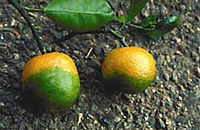
Photo from wikipedia
Asian citrus psyllid, Diaphorina citri, transmits Candidatus Liberibacter asiaticus (CLas), the putative causal agent of Huanglongbing disease. Although they primarily feed on the phloem of Citrus and related plants, when… Click to show full abstract
Asian citrus psyllid, Diaphorina citri, transmits Candidatus Liberibacter asiaticus (CLas), the putative causal agent of Huanglongbing disease. Although they primarily feed on the phloem of Citrus and related plants, when grove or host conditions are unfavorable, D. citri may be able to use weed species as alternate food sources for survival. To explore this possibility, electrical penetration graph (EPG) recordings (18 h) were performed to investigate the feeding behavior of psyllid adults and nymphs on three common south Florida weeds (Bidens alba, Eupatorium capillifolium, and Ludwigia octovalvis). EPG recordings revealed that the proportion of time spent by D. citri feeding on xylem was similar on all tested weed species (19%–22%) and on the positive control (20%), the preferred host, Citrus macrophylla. Very little to no phloem feeding was observed on weed species by either nymphs or adults. Histological studies using epifluorescence microscopy showed that salivary sheaths were branched and extended into xylem of weed species, whereas they ended in phloem on citrus plants. No choice behavioral assays showed that adults can obtain some nutrition by feeding on weed species (xylem feeding) and they may be able to survive on them for short intervals, when host conditions are unfavorable.
Journal Title: Insects
Year Published: 2020
Link to full text (if available)
Share on Social Media: Sign Up to like & get
recommendations!